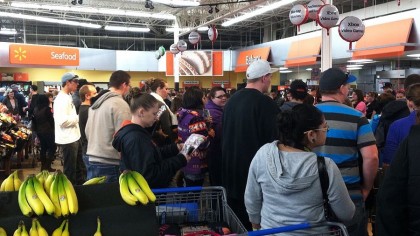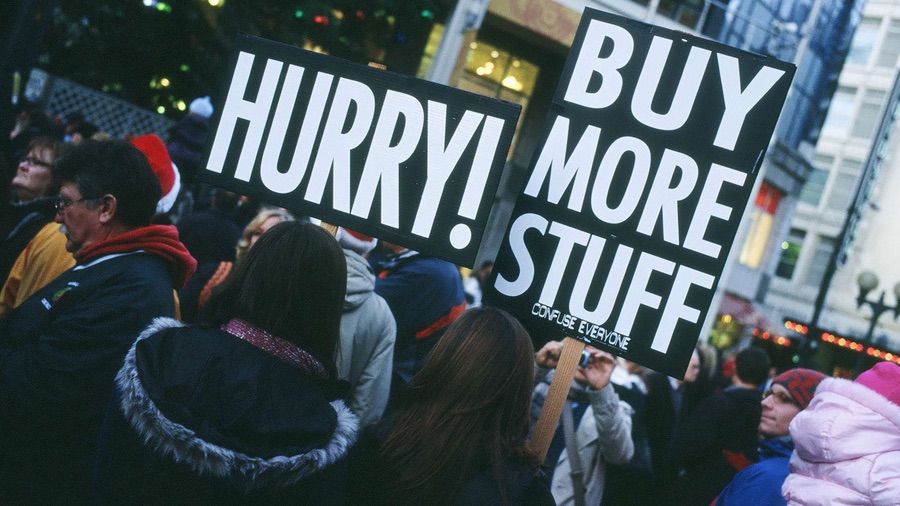Black November: how Black Friday grew, and grew, and grew
The Black Friday origin story

Every year, we think that Black Friday isn't going to get any bigger, whether in the US, UK or other parts of the world. And yet, every year there's another stat that it's been the biggest EVER because shopping online is getting so much easier.
But how did it actually begin - and how did retailers suddenly find one of the biggest shopping bonanzas of the year (and what about Cyber Monday too)?
Well, the first known mention of Black Friday related to this shopping experience was in November 1951, when the journal Factory Management and Maintenance used it to describe people calling in sick the day after Thanksgiving so they could have an extra day off work.
Then back in 1952, two American policemen had a conversation. “Gee,” said one. “There sure is a lot of traffic today, and also a lot of people are off work.” “Yup,” said the other, who might have been on a horse. “It’s the first weekend of the holiday shopping season.” “Dang,” said the first one. “This is going to be a Black Friday indeed.”
That’s more or less how it happened, and more or less how it stayed for a couple of decades. In the US, Black Friday was the Friday after Thanksgiving and the beginning of the Christmas shopping season.
The term itself didn’t really stick until the late 1980s: the New York Times used it to describe Philadelphia’s busiest shopping day of the year in 1975, but as recently as 1985 retailers in LA hadn’t heard of the term.
They knew what it described, though. All over the US, retailers offered “doorbuster” deals immediately after Thanksgiving to get excited customers through their doors. Sometimes the customers got a little too excited, and tales of Black Friday fisticuffs appeared in the newspapers throughout the 2000s.
And then in 2009, Black Friday discovered the internet.

How Black Friday broke the internet
Black Friday wasn’t always the biggest event on the internet. That was Cyber Monday, the Monday after Black Friday when everybody went back to work and did their online Christmas shopping on the work PC.
Retailers noticed this, and in a trend that would repeat years later with Black Friday, they started extending their deals. Coining the term Cyber Black Friday in 2009, the eCoupons website noted that “Cyber Black Friday sales are typically the largest of the season. Online retailers are hoping that by offering early discounts, consumers will shop early and often.”
It was 2009 when the online Black Friday frenzy really kicked off in the US, although it took longer to reach other places: Amazon UK's Black Friday sale had fairly desultory results in 2010, but things didn’t really get interesting until 2011 when the likes of Currys, Comet and PC World got on board and the first big Black Friday in the UK was in 2015.
By 2015 Black Friday was huge online on both sides of The Atlantic, and some retailers were clearly wondering how they could beat the competition on an incredibly busy retail weekend.
Some chose to opt out of Black Friday altogether. In the UK in 2015, Asda decided not to bother. And some firms that did take part, such as Tesco and Currys, found sales disappointing. But some firms found a way to really make Black Friday pay in 2015. They decided to meddle with the very fabric of time to make Friday last a week ...or even longer.
Now the notion of Walmart Black Friday deals, Best Buy deals or even Nintendo Switch deals are the main thing for the whole month of November.

Turning Friday into a fortnight
Amazon’s Black Friday and Cyber Monday deals were offered for longer every year, and for some retailers in 2015 the whole thing had become a fortnight-long frenzy. Most retailers stuck to a week rather than two, but it was clear that one day simply wasn’t long enough any more.
That year wasn’t just remarkable for the ever-lengthening Black Friday period. It was also noteworthy for being one of the most boring Black Fridays ever. Where 2014 saw retailers charging about like headless chickens, discounting things apparently at random in between catastrophic website crashes, Black Friday 2015 was a distinctly sober affair.
As we reported shortly afterwards, while some sites raised eyebrows with “oh! We’re so busy you’ll have to queue!” warnings that seemed more about marketing than reflecting actual demand, most retailers had a strategy in place.
Where 2014 saw retailers charging about like headless chickens, discounting things apparently at random in between catastrophic website crashes, Black Friday 2015 was a distinctly sober affair.
From 2015 onwards, retailers approached Black Friday just like any other sales event. They planned well in advance, negotiated deals with suppliers and generally approached it like grown-ups.
Dull, yes, but effective. By 2016, most big name retailers ran a week of Black Friday deals and we spent accordingly. In the UK alone, consumers spent £6.45 billion over the Black Friday week.
In 2018, we saw over $2bn in sales from smartphones alone - which is a little crazy when you think about people being far more comfortable buying things from their phone.
Give give give me more more more
Retailers have always known that Black Friday isn’t a magic money machine that adds extra spending into the retail year. It just moves existing spending about a bit. Previously we’d shop throughout the holiday season, buying some things here, some things there.
But, as Black Friday became bigger and bigger, more and more of us started doing more and more of our Christmas shopping during the Black Friday period.
As Experian’s Richard Jenkings told the BBC in 2016, “The Black Friday promotions at the end of November are the start of a longer, more drawn-out peak season, which begins with most of the activity online and then moves in-store as we get closer and closer to Christmas day.”
It turns out that concentrating so much spending in such a short period of time can be a real pain for retailers, especially if they don’t have the sheer scale and marketing budgets of firms like Amazon.
Even Amazon is feeling the Black Friday pain now that pretty much everybody in retail is running some kind of Black Friday day, week or month promotion. Since 2015, it’s been focusing its energy on a completely different day: the entirely invented Prime Day, which takes place in July.
Globally, Prime Day 2018 was the biggest sales day in Amazon’s history. So naturally it’s doing what it did with Black Friday, and really stretching the definition of “day”. Prime Day 2017 was a day; Prime Day 2018 was a day and a half and Prime Day 2019 stretched well over two days. That's not really a day, is it?
Amazon is still doing Black Friday. But like most big retailers it’s approaching it as a busier than normal month, not a magic day of irresponsible discounting. It’s a day where you discount carefully because everybody else is doing the same - and Amazon has even claimed that its Prime Day efforts are more valuable to the brand than any other time of the year.
Black Friday 2019: where it’s at
Black Friday is now an institution, a key part of the retail calendar. It’s less exciting than before and likely to involve fewer punch-ups in provincial supermarkets, but there are still plenty of Black Friday deals to be found.
The trick is to separate the wheat from the chaff, the genuine bargains from the impossible RRPs, the good stuff from the guff. And that’s something we’ve become particularly good at - whether it’s a day, a weekend, a week or an entire month, so bookmark our main Black Friday or Cyber Monday page now, as that's where all the top deals will be. Send coffee. We’re going in.
- Black Friday laptop deals: how to get the best model for the best price
Get daily insight, inspiration and deals in your inbox
Sign up for breaking news, reviews, opinion, top tech deals, and more.
Writer, broadcaster, musician and kitchen gadget obsessive Carrie Marshall has been writing about tech since 1998, contributing sage advice and odd opinions to all kinds of magazines and websites as well as writing more than a dozen books. Her memoir, Carrie Kills A Man, is on sale now and her next book, about pop music, is out in 2025. She is the singer in Glaswegian rock band Unquiet Mind.
